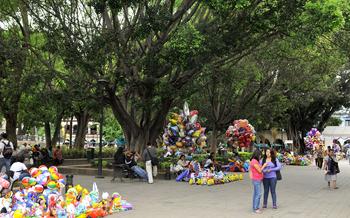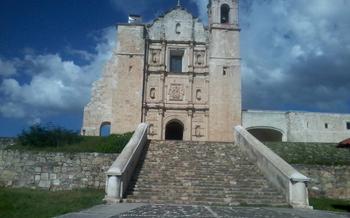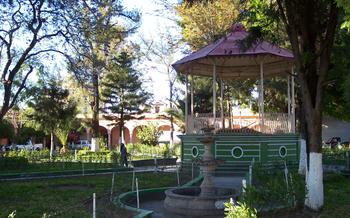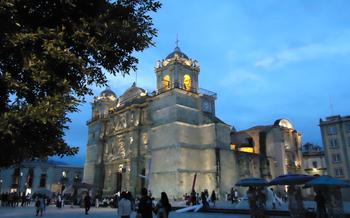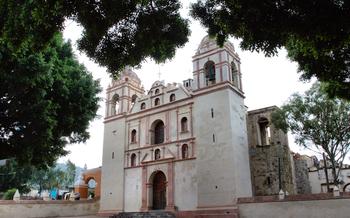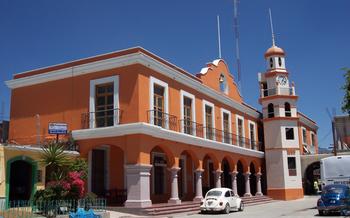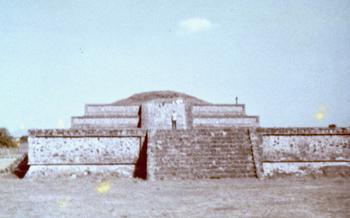
San Pedro y San Pablo Teposcolula
- Architecture and Design
- Cultural Importance
- Visiting the Church
- Historical Context
- Restoration and Preservation
- Local Crafts and Artisans:
- Religious Significance
- Tourism and Economic Impact
- Local Cuisine:
- Nearby Attractions
- Photography Tips
- Insider Tip:
Architecture and Design
The San Pedro y San Pablo Teposcolula stands out for its remarkable architecture, a harmonious blend of Gothic, Renaissance, and Baroque styles. Its façade captivates with intricate carvings and sculptures depicting biblical scenes and indigenous motifs. The church's interior is equally impressive, with vaulted ceilings, elegant arches, and sturdy columns creating a sense of grandeur. The use of local materials and techniques showcases the skill of indigenous artisans, who skillfully incorporated their cultural heritage into the church's design. Adorned with colorful murals, the walls narrate biblical stories and indigenous legends, offering a glimpse into the rich cultural tapestry of the region.
Cultural Importance
The San Pedro y San Pablo Teposcolula church holds immense cultural significance for the local community. It serves as the religious and spiritual center of the town, where residents gather for worship, celebrations, and community events. The annual festivities in honor of the patron saints, San Pedro and San Pablo, attract pilgrims and visitors from near and far. These celebrations, often accompanied by traditional music, dance, and processions, are a testament to the deep devotion and cultural identity of the community.
Beyond religious observances, the church also serves as a gathering place for social and cultural events. It is a venue for meetings, weddings, baptisms, and other important life events. The church's spacious courtyard and surrounding areas provide a welcoming space for community members to interact, share stories, and connect with each other.
The ongoing efforts to preserve and promote the church's cultural heritage are evident in the restoration and maintenance projects undertaken by local authorities and community members. These efforts ensure that the church remains a vibrant and integral part of the town's cultural landscape, showcasing its unique blend of indigenous and European influences.
Visiting the Church
Practical Information:
Visiting the San Pedro y San Pablo Teposcolula church is a rewarding experience that offers a glimpse into Mexico's rich cultural and religious heritage. The church is open to visitors daily, with varying hours depending on the season. Admission fees are minimal, and guided tours are available for a more in-depth understanding of the church's history and significance.
Photography Tips:
The church's striking architecture and elaborate interior provide ample opportunities for photography enthusiasts. To capture the best shots, consider visiting during the golden hours of sunrise or sunset when the warm light enhances the church's facade and surroundings. Use a wide-angle lens to capture the church's grandeur and tripod to ensure sharp images, especially in low-light conditions.
Exploring the Town:
Beyond the church, the town of San Pedro y San Pablo Teposcolula offers a glimpse into traditional Mexican life and culture. Take some time to wander through the cobblestone streets, visit the local market, and interact with the friendly locals. Don't miss the opportunity to sample the town's delicious cuisine, which features regional specialties such as tlayudas (large, crispy tortillas) and mole (a rich, flavorful sauce).
Combining Attractions:
To make the most of your visit, consider combining your exploration of the church with other nearby attractions. The region boasts several historical sites, including the Santo Domingo Yanhuitlan church, known for its intricate stucco work, and the archaeological zone of Yagul, with its well-preserved ruins of a pre-Columbian city. These destinations offer a comprehensive understanding of the region's rich cultural heritage.
Historical Context
The arrival of the Spanish in the 16th century marked a significant turning point in the history of Oaxaca. The Dominican order, known for its missionary work, played a pivotal role in spreading Christianity and establishing churches throughout the region. The 16th century witnessed a surge in colonial architecture and art, as churches like the San Pedro y San Pablo Teposcolula were constructed, showcasing a blend of European and indigenous influences. However, the Mexican Revolution, a tumultuous period in the country's history, brought about significant changes, including the secularization of religious institutions. Despite these challenges, the church has endured, preserving its cultural heritage and serving as a testament to the region's rich history.
Restoration and Preservation
The San Pedro y San Pablo Teposcolula stands as a testament to the enduring legacy of colonial architecture in Mexico. However, safeguarding its architectural integrity and preserving its cultural heritage pose significant challenges. Over time, the church has faced the ravages of natural disasters, neglect, and the passage of time. Recognizing its invaluable significance, local communities and government agencies have undertaken meticulous restoration and preservation efforts to ensure its continued existence for generations to come.
The restoration process involves careful assessment and documentation of the church's condition, identifying areas that require immediate attention. Skilled artisans and conservators employ traditional techniques and materials, meticulously repairing and restoring damaged elements. The focus lies on maintaining the church's authenticity while addressing structural issues and preserving its original features.
Preserving the San Pedro y San Pablo Teposcolula is not merely a matter of maintaining a historical monument; it is also about safeguarding the cultural heritage of the region. The church serves as a reminder of the rich history, artistic traditions, and religious devotion that have shaped the community over centuries. By protecting and promoting this cultural asset, the local community and government agencies ensure that future generations can continue to appreciate and learn from this architectural masterpiece.
The successful restoration and preservation of the San Pedro y San Pablo Teposcolula serve as an exemplary model for cultural heritage conservation in Mexico. It demonstrates the importance of collaboration between local communities, government bodies, and skilled artisans in preserving and promoting the nation's architectural treasures.
Local Crafts and Artisans:
The region surrounding the San Pedro y San Pablo Teposcolula church is renowned for its vibrant tradition of handcrafted goods and traditional arts. Artisans here have inherited skills and techniques passed down through generations, using local materials like wool, clay, and wood to create unique and exquisite pieces. Visitors can find a treasure trove of handmade souvenirs, from intricate woven textiles and colorful pottery to intricately carved wooden figures and traditional jewelry. Supporting local artisans by purchasing their creations not only contributes to the preservation of cultural heritage but also provides a sustainable source of income for the community.
Religious Significance
The San Pedro y San Pablo Teposcolula church holds deep religious significance for the local community and beyond. It serves as a center of Catholic worship and devotion, drawing believers from near and far. The patron saints, San Pedro (Saint Peter) and San Pablo (Saint Paul), are highly revered figures in the community, and annual festivities and processions are held in their honor. These celebrations attract pilgrims who come to pay homage to the saints and seek their blessings. The church's sacred atmosphere and stunning architecture create a sense of awe and inspiration, making it a place of spiritual reflection and connection for many visitors. The ongoing spiritual and religious traditions associated with the church contribute to its enduring importance as a symbol of faith and devotion in the region.
Tourism and Economic Impact
The San Pedro y San Pablo Teposcolula's rising popularity as a tourist destination has a positive impact on the local economy. Tourism creates jobs and opportunities for the community, particularly in the hospitality and service sectors. Hotels, restaurants, and tour operators benefit from the influx of visitors, while local artisans and vendors have the chance to showcase and sell their handcrafted goods.
However, it is crucial to promote sustainable tourism practices to protect the church and its surroundings. Visitors should be encouraged to respect the sanctity of the church and its cultural significance. They should also be mindful of their environmental impact and support local businesses that prioritize sustainability.
Tourism can be a powerful tool for cultural awareness and appreciation. By visiting the San Pedro y San Pablo Teposcolula, travelers gain insights into the region's rich history, architecture, and religious traditions. They also contribute to the preservation and promotion of Mexico's cultural heritage and support the local community's efforts to protect and celebrate their unique identity.
Local Cuisine:
The culinary traditions of the Oaxaca region are a testament to its rich history, diverse ingredients, and unique flavors. When visiting San Pedro y San Pablo Teposcolula, be sure to savor the local cuisine, which offers a tantalizing array of dishes that will delight your taste buds.
For a truly authentic experience, venture into the local markets, where you can find fresh produce, traditional ingredients, and delectable street food. Sample the mouthwatering tlayudas, large tortillas topped with beans, cheese, and various meats, or indulge in the rich flavors of mole, a complex sauce made with a variety of chiles, spices, and chocolate.
For a memorable dining experience, visit one of the local restaurants, where you can savor traditional Oaxacan dishes prepared with fresh, local ingredients. Try the flavorful enchiladas, stuffed with cheese and topped with a spicy sauce, or the hearty pozole, a soup made with hominy, meat, and vegetables.
Supporting local food producers and preserving culinary heritage are essential aspects of experiencing the true essence of San Pedro y San Pablo Teposcolula. By indulging in the local cuisine, you not only satisfy your taste buds but also contribute to the preservation of the region's rich culinary traditions.
Nearby Attractions
San Pedro y San Pablo Teposcolula is surrounded by a wealth of historical and cultural attractions that offer a glimpse into the rich heritage of the region. A short drive away lies the ancient Zapotec city of Mitla, renowned for its intricate stonework and well-preserved ruins. Equally fascinating is the town of Teotitlán del Valle, famous for its traditional Zapotec weaving techniques and colorful textiles. For nature enthusiasts, the majestic Sierra Norte mountains offer breathtaking landscapes, hiking trails, and opportunities for adventure. Whether it's exploring ancient ruins, marveling at traditional crafts, or immersing in the region's natural beauty, there's something for every traveler to discover in the vicinity of San Pedro y San Pablo Teposcolula.
Photography Tips
For photography enthusiasts, the San Pedro y San Pablo Teposcolula presents a treasure trove of captivating subjects. To capture the church's grandeur, consider arriving early in the morning or late in the afternoon to take advantage of the warm, golden light. Use a wide-angle lens to encompass the church's impressive façade and intricate details. Explore different angles and perspectives to create dynamic compositions. Inside the church, focus on the stunning altarpiece, intricately carved choir stalls, and colorful murals. Tripod use is recommended for low-light conditions. Remember to be respectful of the ongoing religious services and maintain silence while taking photographs. Share your captivating images with fellow travelers and photography enthusiasts, inspiring them to embark on their own journey of discovery.
Insider Tip:
Beyond the main tourist attractions, the town of San Pedro y San Pablo Teposcolula holds hidden gems waiting to be discovered. One such gem is the traditional Mercado Municipal, located just a few blocks from the church. This vibrant market offers a glimpse into the daily life of the local community. Visitors can browse stalls selling fresh produce, handmade crafts, and regional delicacies. The market is a great place to interact with friendly locals, learn about their culture, and find unique souvenirs to cherish. Don't miss the opportunity to sample some of the delicious street food, such as tlayudas, a large, crispy tortilla topped with beans, cheese, and various fillings. Exploring the market is a fantastic way to immerse yourself in the authentic atmosphere of San Pedro y San Pablo Teposcolula and connect with its people.
